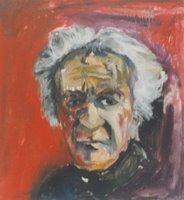
Hello and welcome to Scattered Light.
We are sisters, one a writer, the other a visual artist. We have a few books between us: Janet's Heads (March Street Press) and Flytrap (Cleveland State University Poetry Center) and Cheryl's collections of poetry, and her novels.
We collaborate, but from separate cities.Sometimes the writing gives rise to the art:

Zelig Stalks the Chimera
Chimera stands in her transformations,
misleading us. In chains, she sings songs:
sounds spliced at NIH, splintered
into the less authentic.
The sounds confuse experts of instinct:
owl-heads swivel, hoot at the bats careening
off course. Hybrid roses tip their faces
to the grow-light’s cold and dream of the sun.
The sob that hung still-born in your throat
annihilated us more than my volcano of grief,
rising up out of viscera that had seen better days.
Zelig has something to tell the Chimera.
You rode for miles in your circles
trying to get your story straight. Ever since,
I have suffered. There has been such stitching
and unstitching as you have never seen.
###
And sometimes the art generates the writing:
 Houdini’s Women
Houdini’s WomenI forbade them to speak to each other
across the quarrel of edges that is this box.
I have enough knots to untangle. I hear
stilettos scrape the floor above my head,
pirouetting for an audience that can hold
its breath.
To thwart the next step, I could refuse
to move a corpuscle. Escape has drawbacks--
last minute wing-beats in the ears, a lung
collapsed or drowning. The women, black-veiled,
would turn to each other with proof that my exit
had not been easy, and with a rattle of keys,
break all the locks I had put between us.
###
JS: I think in images. At the easel, I start with an image and begin to improvise the space spontaneously. Spontaneity means being led around by the brush. It is automatic and allows for sensitivity; decisions made from practice and experience, process. Meaning in my paintings is the poetry of image and space, an implied rather than an overt statement on the human condition.
In my portraits, I portray subjects in a semi- expressionistic way, i.e. with undistorted features, but using color and texture more freely, the setting an abstract space.The sitter’s personality dictates the colors used, although some colors are symbolic—yellow for intelligence, for instance. Realistic color pins the personality down.
 This is a portrait of my favorite teacher, the late Ed Dugmore.
This is a portrait of my favorite teacher, the late Ed Dugmore.CS: Janet and I visited Dug and his wife Edie in New York in 1990.This poem recalls my impressions of the evening:
Studio Visit
She baked a meatloaf. He told stories
that hurt her ears: debauched Mexican nights.
Peyote, hallucinations, drowning
in another woman’s arms.
After dinner, they unrolled canvas onto the floor.
When each grazed the other’s empty spaces,
neither one apologized.
Blue oil paint saturated my senses, pounded
my temples like a bass-line. A fugue of colors
sung, grew transparent in their logic and grace.
“Inspired by String Quartet, Opus so and such”
he muttered, finger crooked in a painterly gesture.
When he said goodbye, the painting still tucked
under his arm, we dreaded the moment
he would relinquish it like a useless limb;
and fall silent, so we understood, for days.
His wife would go back to archiving his life; keeping
the portrait you painted next to the bed
like a suicide note.
The meatloaf really was superb, the wine
purple as a bruise.
###
4 comments:
welcome to blogland! i've put a link on my blog. see you around! :)
michi
Thanks, Michi!
congrats on the guardian shortlisting, cheryl! :) a very good poem! :)
m
Thanks, Michi. What a surprise that was!
C
Post a Comment